-
 Optical Genome Mapping: A New Tool for Cytogenomic Analysis
Optical Genome Mapping: A New Tool for Cytogenomic Analysis -
 Genomic Regions Associated with Respiratory Disease in Holstein Calves in the Southern United States
Genomic Regions Associated with Respiratory Disease in Holstein Calves in the Southern United States -
 ABCC6 Involvement in Cerebral Small Vessel Disease: Potential Mechanisms and Associations
ABCC6 Involvement in Cerebral Small Vessel Disease: Potential Mechanisms and Associations -
 Increased Prevalence of Psychiatric Disorders in Children with RASopathies: Comparing NF1, Noonan Syndrome Spectrum Disorder, and the General Population
Increased Prevalence of Psychiatric Disorders in Children with RASopathies: Comparing NF1, Noonan Syndrome Spectrum Disorder, and the General Population -
 Identification of Key Genes Associated with Overall Survival in Glioblastoma Multiforme Using TCGA RNA-Seq Expression Data
Identification of Key Genes Associated with Overall Survival in Glioblastoma Multiforme Using TCGA RNA-Seq Expression Data
Journal Description
Genes
Genes
is a peer-reviewed, open access journal of genetics and genomics published monthly online by MDPI. The Spanish Society for Nitrogen Fixation (SEFIN) is affiliated with Genes and their members receive discounts on the article processing charges.
- Open Access— free for readers, with article processing charges (APC) paid by authors or their institutions.
- High Visibility: indexed within Scopus, SCIE (Web of Science), PubMed, MEDLINE, PMC, Embase, PubAg, and other databases.
- Journal Rank: JCR - Q2 (Genetics and Heredity) / CiteScore - Q2 (Genetics (clinical))
- Rapid Publication: manuscripts are peer-reviewed and a first decision is provided to authors approximately 14.6 days after submission; acceptance to publication is undertaken in 2.5 days (median values for papers published in this journal in the first half of 2025).
- Recognition of Reviewers: Reviewers who provide timely, thorough peer-review reports receive vouchers entitling them to a discount on the APC of their next publication in any MDPI journal, in appreciation of the work done.
Impact Factor:
2.8 (2024);
5-Year Impact Factor:
3.2 (2024)
Latest Articles
Reduced Sensorimotor, Working Memory, and Episodic Memory Abilities in Aging Female FMR1 Premutation Carriers with and Without Fragile X-Associated Tremor/Ataxia Syndrome (FXTAS)
Genes 2025, 16(11), 1331; https://doi.org/10.3390/genes16111331 - 4 Nov 2025
Abstract
Background/Objectives: Fragile X-associated tremor/ataxia syndrome (FXTAS) is characterized by tremor, gait ataxia, and cerebellar white matter degeneration, along with possible cognitive and cerebral changes. Although diagnostic criteria were originally developed in males, emerging evidence suggests that FXTAS may present differently in females. The
[...] Read more.
Background/Objectives: Fragile X-associated tremor/ataxia syndrome (FXTAS) is characterized by tremor, gait ataxia, and cerebellar white matter degeneration, along with possible cognitive and cerebral changes. Although diagnostic criteria were originally developed in males, emerging evidence suggests that FXTAS may present differently in females. The present study examined sensorimotor and memory features of aging in female premutation carriers with (FXTAS+) and without FXTAS (FXTAS+). Methods: We studied 51 female premutation carriers (FXTAS+ = 16, FXTAS− = 35) and 24 age-matched female controls. Participants ranged in age from 47–80 years. All participants completed genetic testing, clinical evaluations, T2-weighted MRIs, and quantitative assessments of sensorimotor (precision grip force task) and memory (reading span; visual paired associates task) functions. Results: During precision grip testing, FXTAS+ carriers showed higher sustained force regularity than FXTAS− carriers (p = 0.03, d = 1.0) and controls (p = 0.004, d = 1.1) at low gain levels only. FXTAS+ participants were slower than controls on motor reaction time (p = 0.009, d = 0.82). Initial force output was higher in FXTAS+ than FXTAS− carriers (p = 0.03, d = 1.0) and controls (p = 0.03, d = 1.0) but at low gain only. FXTAS+ carriers exhibited poorer working memory than FXTAS− carriers (p = 0.03, d = 0.91) and controls (p = 0.02, d = 1.0). During a long-term memory task, FXTAS+ participants were less accurate than FXTAS− carriers (p = 0.04, d = 0.86) and controls (p = 0.004, d = 1.1) and showed increased reaction times relative to FXTAS− carriers (p = 0.03, d = −0.82) and controls (p = 0.01, d = −1.2). Conclusions: Together, these findings indicate that FXTAS+ females exhibit distinct motor and cognitive impairments, underscoring the value of quantitative behavioral measures for detecting and tracking neurodegenerative progression in female premutation carriers.
Full article
(This article belongs to the Special Issue Fragile X Syndrome and Fragile X Premutation Associated Conditions)
►
Show Figures
Open AccessArticle
Thermostable Esterase from Thermophilic Laceyella sacchari: Gene Identification, Heterologous Expression, and Biocatalytic Characterization
by
Yu-Pei Chen, Xingru Zeng, Hsuan-Jung Peng, Ching-Yu Tu, Min Tseng, Li-Ling Liaw, Hongtan Wu, Fangfang Chen and Yang-Cheng Kuo
Genes 2025, 16(11), 1330; https://doi.org/10.3390/genes16111330 - 3 Nov 2025
Abstract
Background/Objectives: Esterases are widely used in various industrial fields. This study aimed to isolate and characterize esterase genes from Laceyella sacchari HS49-1, a thermophilic bacterium from a hot spring, which can survive at 45–60 °C and pH 5-10 with robust esterase activity. Methods:
[...] Read more.
Background/Objectives: Esterases are widely used in various industrial fields. This study aimed to isolate and characterize esterase genes from Laceyella sacchari HS49-1, a thermophilic bacterium from a hot spring, which can survive at 45–60 °C and pH 5-10 with robust esterase activity. Methods: A genomic shotgun library was constructed to identify three esterase genes: two in family XII (Est2 and Est7) and one in family VIII (Est1). Sequence analysis revealed significant divergence from other genera. Only Est1 was successfully expressed in Escherichia coli. Its activity, optimal conditions, thermostability, and structure were investigated using p-NP butyrate, temperature/pH assays, heating pre-treatment, and fluorescence quenching. Results: Est1 demonstrated high activity (57.43 ± 0.04 U/mg) towards short-chain p-NP butyrate (C4). Molecular-docking analyses revealed that Est1’s catalytic motif (GXSXG) interacts with various p-NP esters, with binding energy and interaction types varying by acyl chain length. The optimal temperature was 60 °C, and the optimal pH was 8. Est1 exhibited excellent thermostability, retaining 90% of its activity after pre-treatment at 50 °C for 8 h and 69.8% after pre-treatment at 80 °C for the same duration. Fluorescence quenching showed that after 1 h at 80 °C, the fluorescence was reduced by only 16.6%, indicating remarkable heat resistance. Additionally, Est1 did not require metal ions as cofactors and maintained 74.8% of its activity in the presence of 0.1% SDS. Conclusions: The unique properties of Est1 from L. sacchari HS49-1 highlight its potential for industrial applications. Further exploration of this thermophilic bacterium could uncover more valuable genes.
Full article
(This article belongs to the Section Microbial Genetics and Genomics)
►▼
Show Figures

Figure 1
Open AccessArticle
Transcriptional Activation of the TREM2 Gene by ZEB2 in a Zinc Finger-Dependent Manner
by
Motoaki Yanaizu, Yuji Takata, Masahide Kato, Haruka Fujiwara and Yoshihiro Kino
Genes 2025, 16(11), 1329; https://doi.org/10.3390/genes16111329 - 3 Nov 2025
Abstract
Background/Objectives: TREM2 is a transmembrane receptor highly expressed in microglia and macrophages, and its involvement in Alzheimer’s disease, obesity, and cancer has garnered significant attention. Although its biological function has been actively investigated, the mechanisms by which its expression is regulated remain
[...] Read more.
Background/Objectives: TREM2 is a transmembrane receptor highly expressed in microglia and macrophages, and its involvement in Alzheimer’s disease, obesity, and cancer has garnered significant attention. Although its biological function has been actively investigated, the mechanisms by which its expression is regulated remain incompletely characterized. In this study, we aimed to identify transcription factors that modulate TREM2 expression among those reported to be expressed in microglia. Methods: We inserted a 5 kb upstream region of TREM2 into a luciferase reporter vector. This construct was co-expressed with 15 transcription factors, and the TREM2 transcriptional activity was evaluated using luciferase assays. The most promising transcription factor was subsequently knocked down in HMC3 cells, which are derived from human microglia, to assess its effect on endogenous TREM2 expression. Results: Among the 15 transcription factor candidates tested, SPI1 (PU.1), MAFB, CEBPA, ZEB2, and SALL1 most strongly enhanced TREM2 transcriptional activity. ZEB2 was prioritized due to its limited study in microglia and higher co-expression with TREM2. In HMC3 cells, ZEB2 knockdown reduced both TREM2 mRNA and protein levels. Further analysis using domain-deleted mutants of ZEB2 indicated that the zinc finger domains are essential for its transcriptional activity. Analysis using truncated mutants of the TREM2 upstream region suggests that ZEB2 acts on multiple sites within this region. Chromatin immunoprecipitation also suggested an interaction between ZEB2 and the upstream region of TREM2. Conclusions: This study novelly suggests ZEB2 as a transcription factor that promotes TREM2 expression. Further investigation into the role of ZEB2 in various TREM2-associated diseases is warranted.
Full article
(This article belongs to the Section Human Genomics and Genetic Diseases)
►▼
Show Figures
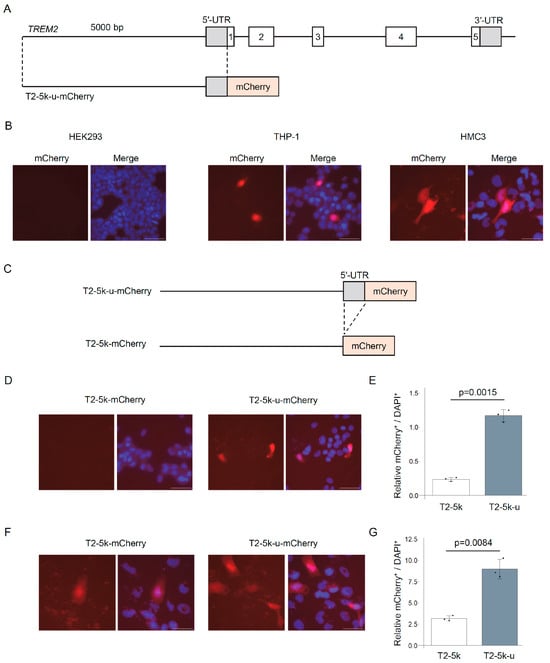
Figure 1
Open AccessReview
Non-Coding RNAs as Emerging Regulators in Kidney Pathophysiology: From Molecular Mechanisms to Therapeutic Potential
by
Petar Todorović, Nikola Pavlović, Mirko Maglica, Patricija Bajt, Nela Kelam, Fila Raguž and Katarina Vukojević
Genes 2025, 16(11), 1328; https://doi.org/10.3390/genes16111328 - 3 Nov 2025
Abstract
The kidney’s intricate physiology relies on finely tuned gene regulatory networks that coordinate cellular responses to metabolic, inflammatory, and fibrotic stress. Beyond protein-coding transcripts, non-coding RNAs (ncRNAs), including microRNAs (miRNAs), long non-coding RNAs (lncRNAs), and circular RNAs (circRNAs), have emerged as pivotal regulators
[...] Read more.
The kidney’s intricate physiology relies on finely tuned gene regulatory networks that coordinate cellular responses to metabolic, inflammatory, and fibrotic stress. Beyond protein-coding transcripts, non-coding RNAs (ncRNAs), including microRNAs (miRNAs), long non-coding RNAs (lncRNAs), and circular RNAs (circRNAs), have emerged as pivotal regulators of renal biology. By modulating transcriptional, post-transcriptional, and epigenetic pathways, ncRNAs govern podocyte integrity, tubular adaptation, intercellular signaling, and immune activation. Dysregulation of these networks is now recognized as a hallmark of major kidney diseases, ranging from diabetic nephropathy and acute kidney injury to chronic kidney disease, glomerulopathies, and polycystic kidney disease. Mechanistic studies have revealed how pathogenic ncRNAs drive apoptosis, inflammation, fibrosis, and cystic remodeling, while protective ncRNAs mitigate these processes, highlighting their dual roles as both disease mediators and therapeutic targets. The exceptional stability of ncRNAs in urine, plasma, and exosomes further positions them as minimally invasive biomarkers with diagnostic and prognostic value. Translational advances include anti-miR and mimic-based therapies (e.g., lademirsen targeting miR-21, miR-29 mimics, anti-miR-17 oligonucleotides), alongside lncRNA silencing strategies, although challenges in delivery, safety, and redundancy remain significant. This review integrates molecular mechanisms with translational perspectives, providing a comprehensive synthesis of how ncRNAs shape renal pathophysiology. By bridging mechanistic insights with emerging diagnostic and therapeutic applications, we highlight the potential of ncRNAs to transform nephrology, paving the way for biomarker-driven precision medicine and novel interventions aimed at intercepting kidney injury at its regulatory roots. In clinical terms, ncRNA-based biomarkers and therapeutics promise earlier detection, more precise risk stratification, and individualized treatment selection within precision nephrology.
Full article
(This article belongs to the Special Issue From Genetic to Molecular Basis of Kidney Diseases)
►▼
Show Figures

Figure 1
Open AccessSystematic Review
Long Non-Coding RNAs in Multiple Sclerosis—Differential Expression and Functional Implications
by
Kaalindi Misra, Aishwary Nerkar, Ferdinando Clarelli, Melissa Sorosina and Federica Esposito
Genes 2025, 16(11), 1327; https://doi.org/10.3390/genes16111327 - 3 Nov 2025
Abstract
Background/Objectives: Long non-coding RNAs (lncRNAs) are increasingly recognized as key regulators of immune pathways and may hold diagnostic and therapeutic relevance in autoimmune diseases such as Multiple Sclerosis (MS). However, research on lncRNAs in MS remains fragmented and geographically clustered. This systematic review
[...] Read more.
Background/Objectives: Long non-coding RNAs (lncRNAs) are increasingly recognized as key regulators of immune pathways and may hold diagnostic and therapeutic relevance in autoimmune diseases such as Multiple Sclerosis (MS). However, research on lncRNAs in MS remains fragmented and geographically clustered. This systematic review aimed to collate and critically evaluate studies of lncRNA expression in MS, assess consistency of findings across studies, and synthesize proposed functional implications of the most frequently studied lncRNAs. Methods: This PROSPERO-registered review (CRD420250575938), conducted in accordance with PRISMA, searched PubMed, Scopus, Embase, and Web of Science (2010–2024) for studies evaluating lncRNA expression in adult MS (≥18 years of age). Eligible studies included ≥20 participants and assessed lncRNAs in blood, PBMCs, serum, plasma, or CSF using qRT-PCR, RNA-seq, or microarrays. Pediatric, review, animal, and in vitro studies were excluded. Two reviewers independently screened and extracted data, with risk of bias evaluated using QUADAS-2. Results: Narrative synthesis of 51 studies identified 77 unique lncRNAs. A limited set (MALAT1, GAS5, MEG3, H19) demonstrated consistent dysregulation in MS, whereas others (THRIL, IFNG-AS1, HOTAIR, TUG1) exhibited context-dependent expression influenced by treatment, relapse status, or demographics. Functional annotations converged on immune pathways, including NF-κB, STAT3, IFN-γ/Th1, and glucocorticoid signaling. Conclusions: This review identifies reproducible and context-specific lncRNA dysregulation in MS, emphasizing the need for transcriptome-wide approaches, standardized methods, and multi-center validation. Current evidence is constrained by geographic clustering, preselection bias, and methodological heterogeneity.
Full article
(This article belongs to the Special Issue The 15th Anniversary of Genes: Feature Papers in the Human Genomics and Genetic Diseases Section)
►▼
Show Figures

Figure 1
Open AccessArticle
STR-Uggles: Overcoming Humic Acid Inhibition Using Combined STR & qPCR Kit Chemistries
by
Caitlin McDonald, Duncan Taylor and Adrian Linacre
Genes 2025, 16(11), 1326; https://doi.org/10.3390/genes16111326 - 3 Nov 2025
Abstract
Background/Objectives: DNA profiling can fail, or produce poor results, when naturally occurring materials are present during the amplification step. This study demonstrates that simple modifications to the reaction setup can overcome this obstacle. PCR inhibition is caused by a range of compounds including
[...] Read more.
Background/Objectives: DNA profiling can fail, or produce poor results, when naturally occurring materials are present during the amplification step. This study demonstrates that simple modifications to the reaction setup can overcome this obstacle. PCR inhibition is caused by a range of compounds including haem, humic acid and dyes. Various strategies to overcome this inhibitory effect have been explored, such as improving extraction methods to remove these compounds, diluting samples to reduce inhibitor concentration, or using inhibitor-tolerant DNA polymerases. In this study, we evaluate whether modified setups can help mitigate the effects of humic acid, a common inhibitor that induces various inhibition mechanisms. Methods: We combined the GlobalFiler STR kit with Investigator Quantiplex Pro into a single reaction. Supplementing the amplification GlobalFiler with additional reagents creates altered amplification environments that use additional DNA polymerase and reaction buffer. Results: The modified setups outperformed the standard GlobalFiler protocol, even at the highest concentration of humic acid tested. The STR reactions supplemented with qPCR reagents produced higher-quality profiles with improved allele amplification and an even peak balance, indicating that a dual-DNA polymerase system offers a more robust and inhibitor-tolerant environment for STR amplification. In addition to demonstrating the value of this combined approach, these data provide a comprehensive dataset characterising the impact of increasing humic acid concentrations on profile quality from an ideal DNA input. Conclusions: For PCR inhibitors with similar mechanisms this approach offers broader applicability in forensic casework and a promising step toward more reliable and robust profiling of inhibited samples.
Full article
(This article belongs to the Special Issue Novel Insights into Forensic Genetics)
►▼
Show Figures

Figure 1
Open AccessArticle
Oxford Nanopore Technologies [ONT] Sequencing: Clinical Validation in Genetically Heterogeneous Disorders
by
Mario Urtis, Chiara Paganini, Viviana Vilardo, Antonio Tescari, Samantha Minetto, Claudia Cavaliere, Andrea Pilotto, Carmela Giorgianni, Alessia Cattaneo, Marilena Tagliani, Maurizia Grasso, Alexandra Smirnova, Payam Ebadi, Valentina Barzon, Valentina Favalli, Andrea Bimbocci, Marta Baragli, Alberto Magi, Alessandra Renieri and Eloisa Arbustini
Genes 2025, 16(11), 1325; https://doi.org/10.3390/genes16111325 - 3 Nov 2025
Abstract
Background/Objectives: Short-read-sequencing (SRS) is currently the standard for genetic testing in inherited human diseases. Intrinsic limitations include PCR dependency, restricted read length, and challenges in identifying structural variants (SVs), copy number variations (CNVs), and intronic small variants (SNVs/indels). Long-read-sequencing (LRS) enables the
[...] Read more.
Background/Objectives: Short-read-sequencing (SRS) is currently the standard for genetic testing in inherited human diseases. Intrinsic limitations include PCR dependency, restricted read length, and challenges in identifying structural variants (SVs), copy number variations (CNVs), and intronic small variants (SNVs/indels). Long-read-sequencing (LRS) enables the sequencing of long DNA molecules, detection of deep intronic variants, rapid testing of few samples, and improved resolution of SVs, CNVs, and SNVs/indels. We therefore aimed to validate Oxford Nanopore Technologies (ONT) LRS for potential clinical application. Methods: We evaluated the ONT’s ability to detect pathogenic/likely pathogenic (P/LP) variants previously identified by SRS and confirmed via Sanger sequencing, Multiplex-Ligation-dependent-Probe-Amplification (MLPA), or quantitative-PCR (qPCR). In total, 509 samples were analyzed, including 393 with P/LP variants and 116 negative controls. We used CE-IVD panels HEVA pro, CARDIO pro, BRaCA panel, and ClinEX pro (4Bases-CH). Sequencing was performed on MinION, GridION, and PromethION-2 platforms. Data were analyzed using the 4eVAR pipeline. Results: ONT successfully identified all P/LP variants across the panels (sensitivity 100%); identified a previously missed CNV in ENG gene; precisely defined the breakpoints of a del(13q) (unsuspected and diagnosed as BRCA2 del ex2–14); improved the coverage profiles in difficult-to-map regions (e.g., ex1 TGFBR1, PSM2CL); expanded the coverage of out-of-target deep intronic regions; and allowed for the set-up of fast-track tests (<24 h) for urgent clinical needs. Conclusions: Our findings demonstrate that ONT LRS provides diagnostic performance comparable to SRS, with significant advantages in resolving complex and previously undetectable variants. Ongoing developments are further increasing read length, expanding detectable targets, and potential clinical applications.
Full article
(This article belongs to the Section Bioinformatics)
►▼
Show Figures
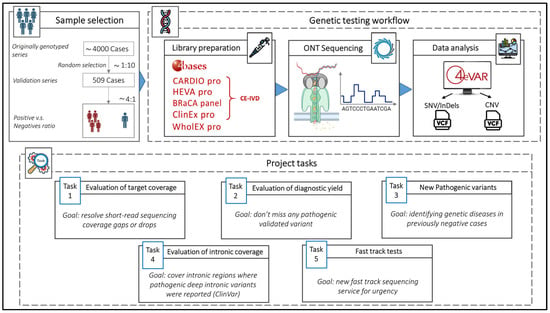
Figure 1
Open AccessArticle
Muscle Oxygen Saturation Responses During Maximal and Submaximal Exercise According to SLC16A1 (MCT1) Gene Polymorphism in Long-Distance Runners: A Cross-Sectional Pilot Study
by
Shotaro Seki, Tetsuro Kobayashi, Naoki Kikuchi, Kosaku Hoshina and Inkwan Hwang
Genes 2025, 16(11), 1324; https://doi.org/10.3390/genes16111324 - 3 Nov 2025
Abstract
Background: Blood lactate concentration and muscle oxygen saturation (SmO2) are widely used indicators of endurance performance, reflecting the balance between oxygen delivery and utilization during exercise. To date, no studies have examined how the rs1049434 polymorphism of the SLC16A1 gene (the
[...] Read more.
Background: Blood lactate concentration and muscle oxygen saturation (SmO2) are widely used indicators of endurance performance, reflecting the balance between oxygen delivery and utilization during exercise. To date, no studies have examined how the rs1049434 polymorphism of the SLC16A1 gene (the polymorphism) influences SmO2 referenced to blood lactate thresholds in long-distance (LD) runners. This pilot study aimed to investigate the association between SmO2 referenced to blood lactate concentration during maximal and submaximal exercise and the polymorphism in male collegiate LD runners. Methods: Overall, 15 Japanese male collegiate LD runners participated. Physiological parameters, including respiratory gas data, were measured during a graded incremental exercise test using the breath-by-breath method. SmO2 was recorded from the right vastus lateralis muscle. Participants were genotyped for rs1049434, and comparisons were made between the AA genotype and T-allele carriers (AT + TT genotype). Results: Runners with the AA genotype exhibited significantly higher %
(This article belongs to the Section Molecular Genetics and Genomics)
►▼
Show Figures
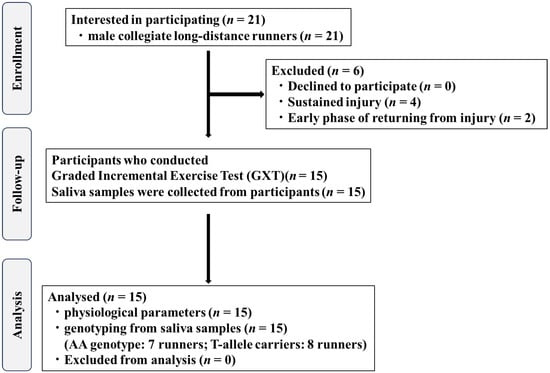
Figure 1
Open AccessArticle
Endometrial Signatures of Subfertility in Beef Heifers Reveal Dysregulation of MAPK Signaling and Ciliary Function
by
Nicholas C. Kertz, Priyanka Banerjee, Paul W. Dyce, Soren P. Rodning and Wellison J. S. Diniz
Genes 2025, 16(11), 1323; https://doi.org/10.3390/genes16111323 - 3 Nov 2025
Abstract
Background: Reproductive efficiency is a significant hurdle to the sustainability of the beef cattle industry. Method: This study employed transcriptomic profiling to investigate endometrial gene expression differences in heifers with divergent fertility outcomes. Caruncular endometrial samples from fertile (n = 7) and
[...] Read more.
Background: Reproductive efficiency is a significant hurdle to the sustainability of the beef cattle industry. Method: This study employed transcriptomic profiling to investigate endometrial gene expression differences in heifers with divergent fertility outcomes. Caruncular endometrial samples from fertile (n = 7) and subfertile (n = 5) heifers were subjected to RNA-Seq analysis, yielding 894 differentially expressed genes (DEGs) (p ≤ 0.05 and |log2FC| ≥ 0.5). Results: The MAPK (Mitogen-activated protein kinase) and Rap1 (Ras-associated protein 1) signaling pathways and immune response regulation were identified among the over-represented pathways underlying the DEGs. Transcriptional regulators, such as DUSP2, DUSP10, and MAPK13, were downregulated in subfertile heifers, suggesting disrupted signal transduction and immune function. Gene co-expression network analysis showed network rewiring and increased connectivity of genes related to cilium organization, motility, and microtubule-based processes in the subfertile group. Over-represented hub genes were enriched in the subfertile endometrium, including DNAH2, DNAI2, DNAAF4, CCDC65, and the transcription factor FOXJ1. Our results suggest that impaired ciliary function and disrupted MAPK and immune signaling could potentially contribute to subfertility. Conclusions: This study highlights novel molecular signatures in the uterine endometrium that may serve as predictive markers of fertility potential in beef heifers, providing a foundation for targeted strategies to improve reproductive performance in cattle.
Full article
(This article belongs to the Special Issue Research on Genetics and Breeding of Cattle)
►▼
Show Figures
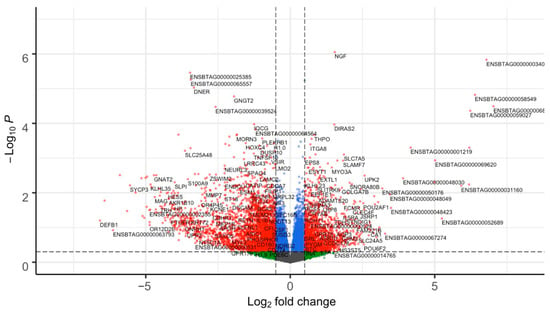
Figure 1
Open AccessArticle
Isoform-Specific Transcriptomic Effects of miR-133A1, miR-133A2, and miR-133B in a Colorectal Cancer Cell Line
by
Ji Su Mo and Youn Ho Han
Genes 2025, 16(11), 1322; https://doi.org/10.3390/genes16111322 - 3 Nov 2025
Abstract
Background: MicroRNA-133 (miR-133) has been implicated in diverse cancers as a tumor suppressor, yet the isoform-specific contributions of miR-133A1, miR-133A2, and miR-133B in colorectal cancer (CRC) remain unclear. Methods: We established stable colorectal cancer cell lines expressing each miR-133
[...] Read more.
Background: MicroRNA-133 (miR-133) has been implicated in diverse cancers as a tumor suppressor, yet the isoform-specific contributions of miR-133A1, miR-133A2, and miR-133B in colorectal cancer (CRC) remain unclear. Methods: We established stable colorectal cancer cell lines expressing each miR-133 isoform and performed isoform-level transcriptomic profiling. Differentially expressed genes (DEGs) were identified relative to parental cells and subjected to gene ontology (GO) and KEGG enrichment analyses. Comparative analyses highlighted both shared and distinct biological pathways regulated by each isoform. Results: Venn diagram and clustering analyses revealed that all three isoforms shared a core regulatory program, with 34 genes consistently upregulated and 195 genes downregulated across all isoforms, while also displaying isoform-specific DEGs. miR-133A1, miR-133A2, and miR-133B showed predominantly convergent transcriptional programs, with subtle quantitative differences observed primarily in KI133B. Heatmap analysis of representative genes confirmed both overlapping and isoform-specific expression changes, with survival- and proliferation-associated genes more strongly upregulated in miR-133A2 and miR-133B. Conclusion: These findings suggest that miR-133 isoforms exert both shared and subtly divergent regulatory functions in colorectal cancer, coordinating apoptosis, proliferation, migration, and signaling network modulation. Isoform-specific transcriptional regulation of miR-133 may contribute to tumor progression and represents a potential biomarker and therapeutic target in CRC.
Full article
(This article belongs to the Section Bioinformatics)
►▼
Show Figures
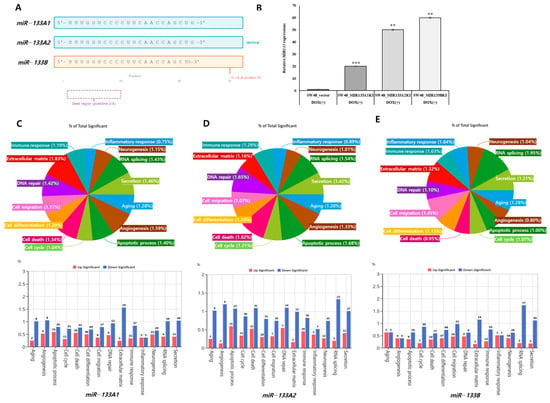
Figure 1
Open AccessArticle
Functional Analysis of the NLR Gene YPR1 from Common Wild Rice (Oryza rufipogon) for Bacterial Blight Resistance
by
Wang Kan, Zaiquan Cheng, Yun Zhang, Bo Wang, Li Liu, Jiaxin Xing, Fuyou Yin, Qiaofang Zhong, Jinlu Li, Dunyu Zhang, Suqin Xiao, Cong Jiang, Tengqiong Yu, Yunyue Wang and Ling Chen
Genes 2025, 16(11), 1321; https://doi.org/10.3390/genes16111321 - 2 Nov 2025
Abstract
Background/Objectives: Bacterial blight (BB) represents one of the most devastating diseases threatening global rice production. Exploring and characterizing disease resistance (R) genes provides an effective strategy for controlling BB and enhancing rice resilience. Common wild rice (Oryza rufipogon) serves as a
[...] Read more.
Background/Objectives: Bacterial blight (BB) represents one of the most devastating diseases threatening global rice production. Exploring and characterizing disease resistance (R) genes provides an effective strategy for controlling BB and enhancing rice resilience. Common wild rice (Oryza rufipogon) serves as a valuable reservoir of genetic diversity and disease resistance resources. In this study, we identified and functionally characterized a novel NLR gene, YPR1, from common wild rice (Oryza rufipogon), which exhibited significant spatial, temporal, and tissue-specific expression patterns. Methods: Using a combination of conventional PCR, RT-PCR, bioinformatics, transgenic analysis, and CRISPR/Cas9 gene-editing approaches, the full-length YPR1 sequence was successfully cloned. Results: The gene spans 4689 bp with a coding sequence (CDS) of 2979 bp, encoding a 992-amino acid protein. Protein domain prediction revealed that YPR1 is a typical CNL-type NLR protein, comprising RX-CC_like, NB-ARC, and LRR domains. The predicted molecular weight of the protein is 112.43 kDa, and the theoretical isoelectric point (pI) is 8.36. The absence of both signal peptide and transmembrane domains suggests that YPR1 functions intracellularly. Furthermore, the presence of multiple phosphorylation sites across diverse residues implies a potential role for post-translational regulation in its signal transduction function. Sequence alignment showed that YPR1 shared 94.02% similarity with Os09g34160 and up to 96.47% identity with its closest homolog in the NCBI database, confirming that YPR1 is a previously unreported gene. To verify its role in disease resistance, an overexpression vector (Ubi–YPR1) was constructed and introduced into the BB-susceptible rice cultivar JG30 via Agrobacterium tumefaciens-mediated transformation. T1 transgenic lines were subsequently inoculated with 15 highly virulent Xanthomonas oryzae pv. oryzae (Xoo) strains. The transgenic plants exhibited strong resistance to eight strains (YM1, YM187, C1, C5, C6, T7147, PB, and HZhj19), demonstrating a broad-spectrum resistance pattern. Conversely, CRISPR/Cas9-mediated knockout of YPR1 in common wild rice resulted in increased susceptibility to most Xoo strains. Although the resistance of knockout lines to strains C7 and YM187 was comparable to that of the wild type (YPWT), the majority of knockout plants exhibited more severe symptoms and significantly lower YPR1 expression levels compared with YPWT. Conclusions: Collectively, these findings demonstrate that YPR1 plays a crucial role in bacterial blight resistance in common wild rice. As a novel CNL-type NLR gene conferring specific resistance to multiple Xoo strains, YPR1 provides a promising genetic resource for the molecular breeding of BB-resistant rice varieties.
Full article
(This article belongs to the Section Plant Genetics and Genomics)
►▼
Show Figures

Figure 1
Open AccessArticle
Forensic Identification of Cannabis with Plant DNA Barcodes and Cannabinoid Synthesis Genes
by
Ping Xiang, Yu Wei Phua, Afiqah Razanah Rosli, Kar Jun Loh and Christopher Kiu-Choong Syn
Genes 2025, 16(11), 1320; https://doi.org/10.3390/genes16111320 - 2 Nov 2025
Abstract
Background/Objectives: According to the World Drug Report 2025, cannabis is the most abused drug in the world, being sold in illicit markets in various physical forms ranging from herbal cannabis to cannabis resin and liquid cannabis. Currently, the methods used for cannabis identification
[...] Read more.
Background/Objectives: According to the World Drug Report 2025, cannabis is the most abused drug in the world, being sold in illicit markets in various physical forms ranging from herbal cannabis to cannabis resin and liquid cannabis. Currently, the methods used for cannabis identification are largely based on the morphological features and chemical content of the product. In this respect, identification could be severely impacted if the product is highly fragmented or pulverised. As such, DNA-based molecular techniques offer a viable alternative detection approach. In this study, we have developed a robust DNA testing method for cannabis identification, with high sensitivity and specificity. Methods/Results: Two plant DNA barcode regions, rbcL and matK, were successfully amplified in a cohort of 54 cannabis plant samples. DNA sequences obtained from these samples were blast-searched against GenBank and resulted in returned matched identity of at least 99% compared to their corresponding Cannabis sativa reference sequences. In addition, the amplification of two cannabis-unique markers, the tetrahydrocannabinolic acid synthase (THCAS) and cannabidiolic acid synthase (CBDAS) genes, produced amplicons with expected sizes only in cannabis samples; these amplicons were not detected in those plants closely related to cannabis. Sequence comparison of the majority of samples yielded at least 97% matched identity against C. sativa reference sequences in GenBank. The THCAS and CBDAS markers detected only the cannabis DNA in varying levels of cannabis–hops and cannabis–tobacco DNA mixtures. Lastly, the use of the four markers could effectively differentiate between cannabis and non-cannabis in 27 blinded samples, including 18 actual casework samples. Conclusions: In conclusion, these four genetic markers can be used to discriminate cannabis from other plant species at the genus level, especially in challenging forensic samples lacking morphological features which therefore cannot be determined by traditional detection methods. As such, this method can complement existing techniques to identify a myriad of cannabis samples.
Full article
(This article belongs to the Special Issue Advances in Forensic Genetics and DNA)
►▼
Show Figures

Figure 1
Open AccessReview
Recent Advances in Pepper Fruit Glossiness
by
Zongjun Li, Hu Zhao, Zihuan Jing, Zengjing Zhao, Meng Wang, Mingxia Gong, Xing Wu, Zhi He, Jianjie Liao, Mengjiao Liu, Zhiyang Ling and Risheng Wang
Genes 2025, 16(11), 1319; https://doi.org/10.3390/genes16111319 - 2 Nov 2025
Abstract
Pepper (Capsicum frutescens L.) is a globally important vegetable crop whose fruit glossiness serves as a key quality trait influencing consumer preference and market value. This review summarizes the measurement methods, influencing factors, and molecular regulatory mechanisms of pepper fruit surface glossiness,
[...] Read more.
Pepper (Capsicum frutescens L.) is a globally important vegetable crop whose fruit glossiness serves as a key quality trait influencing consumer preference and market value. This review summarizes the measurement methods, influencing factors, and molecular regulatory mechanisms of pepper fruit surface glossiness, as well as the correlation between post-harvest changes in carotenoid content and fruit surface glossiness, aiming to provide references for the molecular breeding of high-gloss pepper cultivars. Pepper fruit glossiness is primarily determined by cuticle structure and composition. The content and arrangement of cuticular crystals significantly affect the specular reflection and diffuse reflection on the fruit surface. The ordered arrangement of long-chain alkanes enhances the anisotropy of specular highlights, reduces the contrast of diffuse reflection, and forms a high-gloss surface. In contrast, the imbalance of wax components or disordered accumulation of crystals leads to increased light scattering, resulting in a matte phenotype. Furthermore, carotenoid content strongly correlates with L*, a*, and b*, critically influencing fruit color intensity and hue. Currently, there are still several issues in the research on pepper glossiness, including the lack of standardized measurement methods, unclear gene regulatory networks, and unknown pathways related to post-harvest gloss maintenance and environmental responses. In the future, we should promote the combination of multiple technologies to establish unified measurement standards; integrate multi-omics to identify key genes; develop targeted preservation technologies based on the law of fruit gloss degradation; and breed pepper cultivars with high glossiness and good storage performance.
Full article
(This article belongs to the Section Plant Genetics and Genomics)
►▼
Show Figures

Figure 1
Open AccessReview
The Role of Fc-like Receptor 3 in the Pathophysiology of Rheumatoid Arthritis
by
Paweł Dec, Paulina Plewa, Adam Kubisa and Andrzej Pawlik
Genes 2025, 16(11), 1318; https://doi.org/10.3390/genes16111318 - 2 Nov 2025
Abstract
The pathogenesis of rheumatoid arthritis involves a complex interplay of genetic predisposition, environmental factors, and autoimmune mechanisms that lead to chronic inflammation of the synovial membrane. Fc-like receptor 3 (FcRL3) is a receptor encoded by the FCRL3 gene, located on the long arm
[...] Read more.
The pathogenesis of rheumatoid arthritis involves a complex interplay of genetic predisposition, environmental factors, and autoimmune mechanisms that lead to chronic inflammation of the synovial membrane. Fc-like receptor 3 (FcRL3) is a receptor encoded by the FCRL3 gene, located on the long arm of chromosome 1 at 1q23.1. Polymorphisms in the promoter region of FCRL3, rather than elsewhere in the gene, primarily affect the level of protein expression, which is of clinical significance. Understanding the structure of FcRL3, particularly in the context of genetic variants, is therefore important for elucidating the pathogenesis of autoimmune diseases. Detailed knowledge of the molecular architecture of immune receptors such as FcRL3 is also essential for advancing our understanding of immune function and for guiding the development of targeted therapeutic strategies in autoimmune disease. In this article, we discuss the role of FcRL3 in the pathophysiology and potential therapy of rheumatoid arthritis.
Full article
(This article belongs to the Section Human Genomics and Genetic Diseases)
►▼
Show Figures
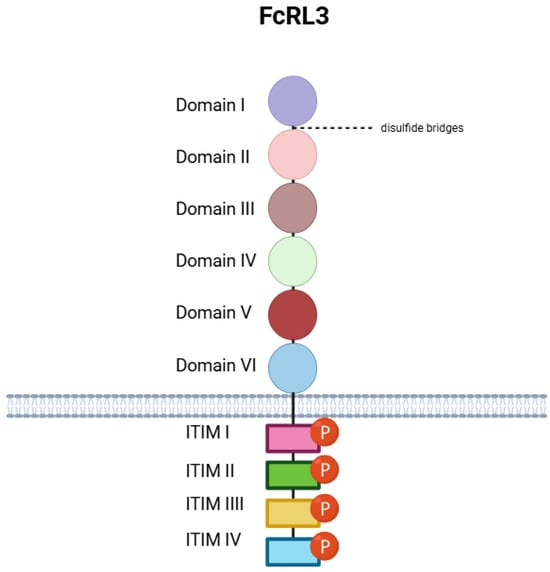
Figure 1
Open AccessReview
Sex-Specific Molecular and Genomic Responses to Endocrine Disruptors in Aquatic Species: The Central Role of Vitellogenin
by
Faustina Barbara Cannea, Cristina Porcu, Maria Cristina Follesa and Alessandra Padiglia
Genes 2025, 16(11), 1317; https://doi.org/10.3390/genes16111317 - 2 Nov 2025
Abstract
Endocrine-disrupting chemicals (EDCs) are widespread contaminants that interfere with hormonal signaling and compromise reproductive success in aquatic organisms. Vitellogenin (VTG) is one of the most widely established biomarkers of estrogenic exposure, especially in males and juveniles. However, evidence from multi-omics studies indicates that
[...] Read more.
Endocrine-disrupting chemicals (EDCs) are widespread contaminants that interfere with hormonal signaling and compromise reproductive success in aquatic organisms. Vitellogenin (VTG) is one of the most widely established biomarkers of estrogenic exposure, especially in males and juveniles. However, evidence from multi-omics studies indicates that VTG induction occurs within broader transcriptional and regulatory networks, involving genes such as cyp19a1 (aromatase), cyp1a (cytochrome P4501A), and other stress-responsive genes, underscoring the complexity of endocrine disruption. This review focuses on nuclear receptor isoforms, including estrogen receptor alpha (ERα), estrogen receptor beta (ERβ), and androgen receptor (AR) variants. We examine the diversification of vtg gene repertoires across teleost genomes and epigenetic mechanisms, such as DNA methylation and microRNAs, that modulate sex-dependent sensitivity. In addition, we discuss integrative approaches that combine VTG with transcriptomic, epigenetic, and histological endpoints. Within the Adverse Outcome Pathway (AOP) and weight-of-evidence (WoE) frameworks, these strategies provide mechanistic links between receptor activation and reproductive impairment. Finally, we outline future directions, focusing on the development of sex-specific biomarker panels, the integration of omics-based data with machine learning, and advances in ecogenomics. Embedding molecular responses into ecological and regulatory contexts will help bridge mechanistic insights with environmental relevance and support sustainability goals such as SDG 14 (Life Below Water).
Full article
(This article belongs to the Section Animal Genetics and Genomics)
►▼
Show Figures

Figure 1
Open AccessArticle
Expression Profile and Clinical Relevance of ADAR Family Genes in Head and Neck Squamous Cell Carcinoma
by
Tomasz Kolenda, Piotr Białas, Paulina Poter, Marlena Janiczek-Polewska, Anna Zapłata, Kacper Guglas, Patrycja Mantaj, Anna Przybyła, Urszula Kazimierczak, Ewa Leporowska, Zefiryn Cybulski and Anna Teresiak
Genes 2025, 16(11), 1316; https://doi.org/10.3390/genes16111316 - 2 Nov 2025
Abstract
Background: ADAR1 (ADAR), ADAR2 (ADARB1), and ADAR3 (ADARB2) are deaminase adenosine RNA-specific enzymes that play a significant role in RNA metabolism. ADAR1 (ADAR) and ADAR2 (ADARB1) catalyze A-to-I editing and ADAR3 (ADARB2
[...] Read more.
Background: ADAR1 (ADAR), ADAR2 (ADARB1), and ADAR3 (ADARB2) are deaminase adenosine RNA-specific enzymes that play a significant role in RNA metabolism. ADAR1 (ADAR) and ADAR2 (ADARB1) catalyze A-to-I editing and ADAR3 (ADARB2) plays a regulatory role. The role of these three genes still remains unknown in head and neck cancers (HNSCC). The aim of this study is to reveal the role of deaminase adenosine RNA-specific enzymes in pathomechanisms of HNSCC and to investigate their potential utility as diagnostic and/or prognostic biomarkers. Methods: The quantitative PCR analysis was conducted using RNA isolated from 22 pairs of matched tumor and adjacent normal tissues, 76 formalin-fixed paraffin-embedded (FFPE) tumor samples, and a panel of HNSCC cell lines (DOK, SCC-25, SCC-40, FaDu, and CAL-27). In parallel, transcriptomic and clinical data from the Cancer Genome Atlas HNSCC cohort were analyzed. Patients were stratified into high- and low-expression groups, and statistical assessments included overall survival and progression-free interval analyses, evaluation of gene expression in relation to clinicopathological parameters, correlation with other genes, and functional pathway exploration using gene set enrichment analysis. Results: ADARB2 was significantly downregulated in HNSCC tumor tissues compared to adjacent normal mucosa (p = 0.044), with discriminatory potential to distinguish malignant from non-malignant tissues (AUC = 0.692, p = 0.029). TCGA data confirmed ADAR (p < 0.0001) and ADARB1 (p < 0.0001) upregulation in tumors, while ADARB2 was markedly reduced (p = 0.04). Patients with high ADARB2 expression showed significantly longer overall survival (pa = 0.0121; pb = 0.0098), with a trend toward improved progression-free survival (pb = 0.0681). Subsite analysis revealed high ADAR expression correlated with poor OS in pharyngeal tumors (p < 0.05), whereas high ADARB2 expression was linked to improved DFS (pa = 0.0023, pb = 0.0047). GSEA indicated that low ADARB2 expression was enriched in oncogenic pathways, including Wnt/β-catenin (p = 0.006), MYC targets (p = 0.009), and TGF-β1 (p = 0.009). Conclusions: ADARB2 expression was significantly reduced in HNSCC tumor tissues compared to normal mucosa and demonstrated strong discriminatory power for distinguishing malignant from non-malignant samples. High ADARB2 expression was associated with markedly improved overall survival, whereas low expression correlated with enrichment of oncogenic pathways, including Wnt/β-catenin, Notch, and Hedgehog, consistent with a poorer clinical prognosis. These findings highlight ADARB2 as a promising diagnostic biomarker and independent prognostic factor in HNSCC.
Full article
(This article belongs to the Section Human Genomics and Genetic Diseases)
►▼
Show Figures

Figure 1
Open AccessArticle
A Nationwide Analysis of the Phenotype/Genotype Landscape of Hemophagocytic Lymphohistiocytosis: UNC13D Associates with Poor Prognosis
by
Dafna Brik Simon, Yarden Greental Ness, Orly Dgany, Sharon Noy-Lotan, Tanya Krasnov, Galit Berger, Tamar Feuerstein, Jerry Stein, Aviva Kraus, Asaf Yanir, Assaf Barg, Elad Jacoby, Noa Mandel-Shorer, Dan Harlev, Ehud Even-Or, Hannah Tamary, Oded Gilad, Orna Steinberg-Shemer and Joanne Yacobovich
Genes 2025, 16(11), 1315; https://doi.org/10.3390/genes16111315 - 2 Nov 2025
Abstract
Background/objectives: Geographic and ethnic differences influence the genetic landscape of hemophagocytic lymphohistiocytosis (HLH) and the frequency of familial HLH (FHL); this in turn can affect outcomes. Methods: We collected data on 98 patients treated for HLH between 1 January 2001 and 31 July
[...] Read more.
Background/objectives: Geographic and ethnic differences influence the genetic landscape of hemophagocytic lymphohistiocytosis (HLH) and the frequency of familial HLH (FHL); this in turn can affect outcomes. Methods: We collected data on 98 patients treated for HLH between 1 January 2001 and 31 July 2024 at four tertiary centers, characterizing the genotype/phenotype correlations. Results: Half of the patients, 51 (52%), were symptomatic by age 1 year and 43 (44%) were diagnosed by that age. Our varied population included 43% Sephardic/Ashkenazi/Ethiopian Jews, 50% Muslim Arabs, and 7% Druze. Molecular analysis was performed on 90.5% of patients and revealed an FHL-related variant in 72%. The genetic variation included biallelic variants in PRF1 (21), UNC13D (12), STXBP2 (15), and STX (1). Eight hemizygous variants were found in X-linked lymphoproliferative disorder-related genes. A RAB27A monoallelic variant in an infant with a severe phenotype was considered pathogenic. The recently described HLH-related gene, ZNFX1, was mutated with varying penetrance in three symptomatic siblings. Overall, of the 94/98 with follow-up, 77% are alive. Strikingly, 5/12 (41.6%) patients with UNC13D variants died while 14/15 (93.3%) patients with STXBP2 variants survived. Logistic regression found poor prognosis associated with young age at diagnosis (p < 0.001), any variant (p = 0.016), UNC13D variant (p < 0.001), poor initial treatment response (p = 0.009), and no BMT (p = 0.005). Conclusions: Our cohort included an extremely high rate of genetic testing and detection of FHL-related variants. UNC13D variations are associated with exceedingly poor outcomes. Response to initial treatment seems crucial for positive outcomes, as does access to hematopoietic stem cell transplantation. Overall, we report a high survival rate, possibly due to a high index of suspicion and prompt diagnosis.
Full article
(This article belongs to the Special Issue Phenotypic Variability of Genetic Diseases in Children)
►▼
Show Figures

Figure 1
Open AccessArticle
The Combined Expression Profiles of Epigenetic Biomarkers Reveal Heterogeneity in Normospermic Human Sperm Samples
by
Nino-Guy Cassuto, Florence Boitrelle, Lea Ruoso, Omar Bouattane, Marion Bendayan, Lina Abdiche, Lionel Larue, Gwenola Keromnes, Nathalie Lédée, Laura Prat-Ellenberg, Geraldine Dray, Alexandre Rouen, John De Vos and Said Assou
Genes 2025, 16(11), 1314; https://doi.org/10.3390/genes16111314 - 2 Nov 2025
Abstract
Background: Male infertility is evaluated using standard semen parameters. However, these criteria offer limited insight into sperm functionality and poorly predict natural fertility or assisted reproductive technology (ART) outcomes. Methods: In this study, the expression levels of three genes (AURKA, HDAC4
[...] Read more.
Background: Male infertility is evaluated using standard semen parameters. However, these criteria offer limited insight into sperm functionality and poorly predict natural fertility or assisted reproductive technology (ART) outcomes. Methods: In this study, the expression levels of three genes (AURKA, HDAC4, and CARHSP1) involved in mitosis regulation, epigenetic modulation and early embryonic development, were measured by RT-qPCR in sperm samples (training dataset). For each gene, thresholds of normal and reduced expression were established by biostatistical modeling and combined with the number of motile spermatozoa to develop the Spermatozoa Function Index (SFI). Results: The ROC analysis was used to interpret the SFI values: SFI > 320 (normal), 290–320 (intermediate), and <290 (low). Then, this index was validated using 627 fresh semen samples from 25- to 60-year-old men at our ART center. Based on the World Health Organization criteria, 54.5% of the 627 sperm samples were normospermic, 8.8% showed oligo-astheno-teratospermia, and 36.6% had one or two abnormal parameters. According to the SFI values, 41% of sperm samples displayed normal expression, 55.9% low expression, and 4.1% intermediate expression. Only 57% of the 342 normospermic samples had normal SFI values and 37% had low SFI values. Among the 81 samples with stringent normal criteria (≥50 million/mL, ≥50% total motility, ≥14% normal morphology), 67.9% displayed normal SFI and 22.2% low SFI values. These findings suggest that even sperm with normal parameters may harbor dysfunctions. Conclusions: Our data highlight a gene signature with strong discriminatory power and promising diagnostic value for detecting subclinical sperm defects and improving male infertility assessment.
Full article
(This article belongs to the Section Epigenomics)
►▼
Show Figures

Figure 1
Open AccessArticle
FLI1 Expression in Invasive Breast Carcinoma: Clinicopathological Correlations and Prognostic Implications
by
Nusrat Jahan Doly, Dong Yeul Lee, Kazi Nafisa Tahsin, Jhuma Akhter, Shahana Sultana, Julekha Khatun, Sue-zann Chua, A. Tasleema Banu, Qingfeng Chen and Jabed Iqbal
Genes 2025, 16(11), 1313; https://doi.org/10.3390/genes16111313 - 2 Nov 2025
Abstract
Background: The E26 transformation-specific (ETS) transcription factor Friend Leukemia Integration 1 (FLI1) has been linked to breast cancer aggressiveness, stromal remodeling, and immune modulation, yet the regulatory mechanisms governing its activity remain poorly defined. Of note, various studies have shown that EWS-FLI1-mediated transcription
[...] Read more.
Background: The E26 transformation-specific (ETS) transcription factor Friend Leukemia Integration 1 (FLI1) has been linked to breast cancer aggressiveness, stromal remodeling, and immune modulation, yet the regulatory mechanisms governing its activity remain poorly defined. Of note, various studies have shown that EWS-FLI1-mediated transcription programs are facilitated via direct recruitment and binding of the NuRD-LSD1 complex, regulating its associated gene targets. Furthermore, LSD1 inhibition exhibited reverse transcriptional profiles driven by ETS-FLI and reduced in vivo tumorigenesis in cancers. Methods: We evaluated FLI1 expression across multiple invasive breast carcinoma (IBC) cohorts to determine its prognostic significance and associations with stromal features. In parallel, we investigated FLI1 regulation in humanized breast cancer mouse models treated with an LSD1 inhibitor. Results: High FLI1 expression was associated with advanced histological grade in IBC, consistent with an oncogenic function. FLI1-high tumors also exhibited elevated stromal and immune scores, indicating a role in remodeling the tumor microenvironment. Additionally, LSD1 inhibition downregulated FLI1 target genes involving angiogenesis and invasion. Conclusions: These findings highlight the dual role of FLI1: tumor-intrinsic FLI1 promotes proliferation and invasion, whereas its transcriptional regulation in tumor and endothelial compartments likely reflects LSD1 dependence. Collectively, our results support a mechanistic model in which LSD1–FLI1 crosstalk is involved in immune and stromal remodeling, positioning FLI1 as both a marker of tumor aggressiveness and a potential predictor of response to epigenetic therapies in breast cancer.
Full article
(This article belongs to the Special Issue Genetics and Genomics of Human Breast Cancer)
►▼
Show Figures

Figure 1
Open AccessReview
The miR-200 Family in Non-Small-Cell Lung Cancer: Molecular Mechanisms, Clinical Applications, and Therapeutic Implications
by
Nobuaki Kobayashi, Yukihito Kajita, Fangfei Yang, Nobuhiko Fukuda, Kohei Somekawa, Ayami Kaneko and Seigo Katakura
Genes 2025, 16(11), 1312; https://doi.org/10.3390/genes16111312 - 2 Nov 2025
Abstract
Non-small-cell lung cancer (NSCLC) remains a leading cause of cancer-related mortality worldwide, demanding improved biomarkers and therapeutic approaches. This review synthesizes the extensive evidence positioning the miR-200 family as a master regulator of NSCLC progression. We detail the core molecular circuitry centered on
[...] Read more.
Non-small-cell lung cancer (NSCLC) remains a leading cause of cancer-related mortality worldwide, demanding improved biomarkers and therapeutic approaches. This review synthesizes the extensive evidence positioning the miR-200 family as a master regulator of NSCLC progression. We detail the core molecular circuitry centered on the bistable, double-negative feedback loop between miR-200 and the ZEB1/ZEB2 transcription factors, which governs epithelial–mesenchymal transition (EMT). This review connects this central mechanism to critical clinical challenges, including the development of resistance to EGFR-targeted therapies and the regulation of immune evasion through PD-L1 expression and CD8+ T cell infiltration. We evaluate the strong clinical evidence for the miR-200 family’s utility as a diagnostic, prognostic, and predictive biomarker. Finally, we explore emerging therapeutic strategies that target this network, including miRNA replacement, epigenetic reactivation, and rational combinations with immunotherapy and targeted agents. We synthesize evidence positioning the miR-200/ZEB feedback circuit as a central regulatory node in NSCLC that links EMT with therapeutic resistance and immune evasion. Beyond summarizing associations, we interpret how this circuitry could inform biomarker development and rational combinations with targeted and immune therapies. Given heterogeneous study designs and non-standardized assays, translational claims remain provisional; we outline immediate priorities for assay harmonization and biomarker-stratified trials.
Full article
(This article belongs to the Section Human Genomics and Genetic Diseases)
►▼
Show Figures

Figure 1

Journal Menu
► ▼ Journal Menu-
- Genes Home
- Aims & Scope
- Editorial Board
- Reviewer Board
- Topical Advisory Panel
- Instructions for Authors
- Special Issues
- Topics
- Sections & Collections
- Article Processing Charge
- Indexing & Archiving
- Editor’s Choice Articles
- Most Cited & Viewed
- Journal Statistics
- Journal History
- Journal Awards
- Society Collaborations
- Conferences
- Editorial Office
Journal Browser
► ▼ Journal BrowserHighly Accessed Articles
Latest Books
E-Mail Alert
News
Topics
Topic in
Brain Sciences, CIMB, Epigenomes, Genes, IJMS, DNA
Genetics and Epigenetics of Substance Use Disorders
Topic Editors: Aleksandra Suchanecka, Anna Maria Grzywacz, Kszysztof ChmielowiecDeadline: 15 November 2025
Topic in
Animals, CIMB, Genes, IJMS, DNA
Advances in Molecular Genetics and Breeding of Cattle, Sheep, and Goats
Topic Editors: Xiukai Cao, Hui Li, Huitong ZhouDeadline: 30 November 2025
Topic in
BioTech, DNA, Genes, IJMS, CIMB
Single-Cell Technologies: From Research to Application
Topic Editors: Ken-Hong Lim, Chung-Der Hsiao, Pei-Ming YangDeadline: 31 December 2025
Topic in
Animals, Dairy, Genes, Agriculture, Poultry, Ruminants, Veterinary Sciences
Application of Reproductive and Genomic Biotechnologies for Livestock Breeding and Selection: 2nd Edition
Topic Editors: Manuel García-Herreros, Pedro Manuel AponteDeadline: 30 April 2026

Conferences
Special Issues
Special Issue in
Genes
Genetic, Epigenetic and Environmental Factors in Dental Development and Pathologies: Genes, Interactions and Dental Development
Guest Editor: Alan H. BrookDeadline: 5 November 2025
Special Issue in
Genes
Genetics in Motor Neuron Diseases
Guest Editor: Christopher GrunseichDeadline: 5 November 2025
Special Issue in
Genes
Genetics and Genomics of Lung Cancer
Guest Editor: Elisa FrullantiDeadline: 10 November 2025
Topical Collections
Topical Collection in
Genes
Tools for Population and Evolutionary Genetics
Collection Editors: David Alvarez-Ponce, Julie M. Allen, Won C. Yim, Marco Fondi
Topical Collection in
Genes
Eukaryotic Non-coding RNAs: Diversity, Structure/Function, Implication in Cardiovascular Disease
Collection Editors: Morten Andre Høydal, Christiane Branlant
Topical Collection in
Genes
Genetics and Genomics of Hereditary Disorders of Connective Tissue
Collection Editors: Nazli B. Mcdonnell, Bert Callewaert, Clair A. Francomano, Philippe Khau-Van-Kien, Yves Dulac








